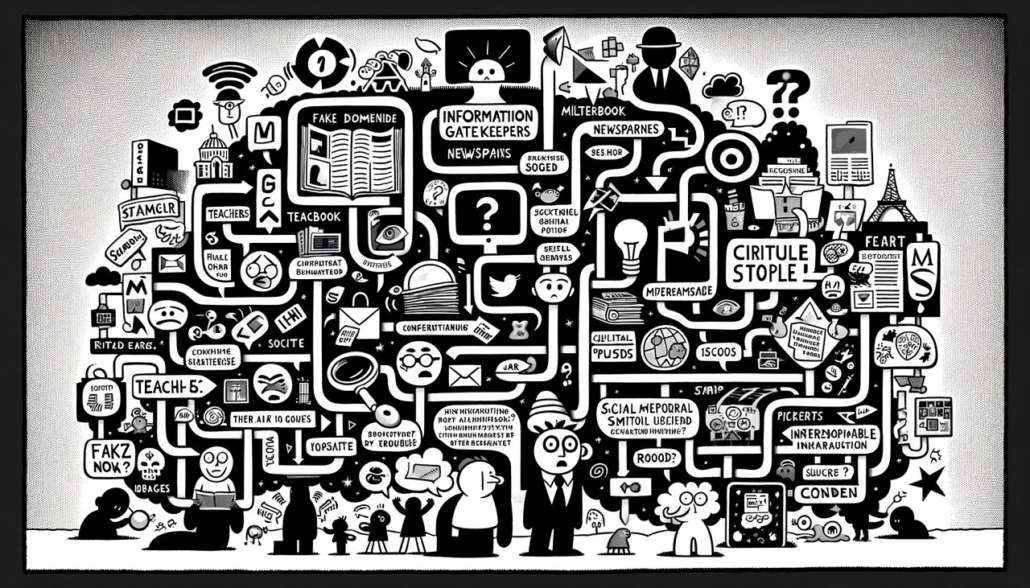ERIC’S TECH TALK: The new misinformation landscape

 by Eric W. Austin
by Eric W. Austin
In the lead-up to the 2024 elections, the problem of misinformation looms larger than ever before. The information landscape has changed drastically over recent decades, and many of us have not developed the tools to discern good information from bad quickly enough to keep pace with these changes. Let’s explore how things were in the past, how they have evolved, and what we can do to navigate this new terrain.
In the past, our information was filtered through a series of gatekeepers, such as teachers, librarians, publishers, newspapers, and the major news broadcasters. These gatekeepers, equipped with the skills to discern reliable information, ensured that the public received mostly accurate news and information. This system fostered a relatively unified understanding of the world, which was particularly valuable in times of crisis. However, it also meant that a small group decided which narratives were worthy of dissemination, limiting the diversity of perspectives.
The landscape began to shift in the late 1980s with the elimination of the Fairness Doctrine, a policy that required broadcasters to present contrasting viewpoints on controversial issues. Whether one views this as a positive change or not, its repeal allowed for the rise of ideologically driven news stations catering to specific segments of the population, leading to the ideological drift and “information bubbles” we see today.
The advent of the internet further transformed the information landscape. Traditional gatekeepers were bypassed, and information became ubiquitous and accessible to all. This democratization of information had its benefits, allowing for a greater diversity of viewpoints and giving voice to previously suppressed perspectives. However, it also meant that anyone, regardless of their expertise or intentions, could disseminate information widely. This led to a reliance on emotional responses and confirmation bias to determine the value of information rather than its truthfulness or societal benefit.
Social media platforms, particularly with the introduction of Facebook’s “Like” button in 2009, exacerbated the problem. These platforms reward content that generates engagement, often prioritizing sensational or misleading information. The lack of accountability for false or harmful content has allowed misinformation to flourish, with creators incentivized by the prospect of financial gain through ad revenue sharing on platforms like YouTube and Twitter (now X).
The influence of social media influencers has further complicated the landscape. Individuals can amass millions of followers based on content like pranks or lifestyle posts, and then leverage that influence to spread conspiracies or misinformation. This unchecked power can be exploited by political, criminal, or foreign entities for nefarious purposes.
New Artificial Intelligence (AI) technologies have made the situation even more perilous. AI can create photorealistic images, simulate voices, and generate realistic videos, making it increasingly difficult to distinguish between real and fake content. This technological advancement, combined with the breakdown of traditional gatekeeping, has created a breeding ground for misinformation.
So, what can we do about it? First, we must recognize the need to develop new skills for discerning good information from bad. Many of us overestimate our ability to identify reliable information. To counter this, we should seek out media literacy classes, read books on detecting fake information, and educate ourselves about common biases and fallacies. Media literacy education should also be integrated into school curriculums to prepare future generations for this new information environment.
Here are a few practical tips to navigate the current landscape:
• Find Trusted Sources: Identify credible sources from across the political spectrum. Research them thoroughly and use them as a benchmark to evaluate new information.
• Be Aware of Bias: Acknowledge your own biases and be cautious of information that confirms your preconceptions.
• Verify Information: Be skeptical of information from unknown sources, especially screenshots of articles or headlines shared on social media.
• Research Your Sources Thoroughly: Check the credibility of new sources using tools like AllSides, MediaBiasFactCheck, and Ground News. Scan a source’s Wikipedia page and do a Google search to identify any red flags. Also, look for funding transparency from websites and news organizations.
Ultimately, we must remain vigilant and humble. Overconfidence in our ability to discern truth from falsehood makes us more susceptible to deception. By staying informed and critically evaluating the information we consume, we can better navigate this complex information landscape and make informed decisions, especially as we approach the crucial 2024 elections.
Responsible journalism is hard work!
It is also expensive!
If you enjoy reading The Town Line and the good news we bring you each week, would you consider a donation to help us continue the work we’re doing?
The Town Line is a 501(c)(3) nonprofit private foundation, and all donations are tax deductible under the Internal Revenue Service code.
To help, please visit our online donation page or mail a check payable to The Town Line, PO Box 89, South China, ME 04358. Your contribution is appreciated!


Leave a Reply
Want to join the discussion?Feel free to contribute!